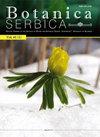在潘诺尼亚平原南部的拉姆萨尔遗址上建立了高度侵入性的棘囊藻
IF 1.1
4区 生物学
Q4 PLANT SCIENCES
引用次数: 3
摘要
监测自然湿地中入侵物种的存在是至关重要的,原因有很多,包括它们对生物多样性、保护和这些重要脆弱地区提供的生态系统服务的负面影响。研究了潘诺尼亚平原南部(中欧东南部、塞尔维亚北部)拉姆萨尔湿地高度入侵野生黄瓜(Echinocystis lobata)的存在和分布,并确定了其与本地植物的群落关系。在2011-2015年和2020年的6年时间里,我们对选定的河岸保护区进行了详细的植物生态学研究。研究结果表明,高入侵性植物叶裂叶蝉(E. lobata)在研究地点显著存在。在7个调查地区中,有4个地区的146个地块中发现了野生黄瓜。聚类分析区分出四组相关因子。其中,以野田鼠为优势种,鉴定出其优势种和恒定种。进行了生境类型鉴定,确定了野田鼠的生境偏好。这四个群体的空间分布是这样的,它们出现在许多不同的栖息地类型或当地社区。因此,构成这四个群落的物种池在地理上比所研究的当地群落大,因此我们可以将它们视为独立建立和定义明确的新群落组合。以外来入侵物种绿叶莲为主导的植物群落尚未见报道。因此,本工作提供了新的数据,有助于进一步研究和比较分析以野生黄瓜为主导的入侵植物群落。此外,确定大叶蝉占据最多的生境类型对保护区管理者来说非常重要,因为这可以使他们更好地控制和清除这种高度入侵物种,同时也可以防止其进一步传播。本文章由计算机程序翻译,如有差异,请以英文原文为准。
Established stands of the highly invasive Echinocystis lobata on the Ramsar sites of the southern part of the Pannonian plain
Monitoring the presence of invasive species in natural wetlands is crucial for numerous reasons, including their negative impact on biodiversity, conservation and the ecosystem services provided by these important fragile areas. The aim of this paper was to investigate the presence and distribution of the highly invasive liana Echinocystis lobata (wild cucumber), and to determine its coenological relations with the native plant species in the Ramsar sites of the southern part of the Pannonian Plain (the southeastern part of Central Europe, northern Serbia). We conducted the phytocenological research of the selected protected riparian areas in detail over a six-year period (2011-2015 and 2020). This study revealed the significant presence of the highly invasive species E. lobata in the studied sites. Wild cucumbers were found in 146 plots in four out of the seven investigated areas. Cluster analyses distinguished four groups of relev?s dominated by E. lobata, which were described, and their dominant and constant species were identified. Habitat type identification was done, and the habitat preferences of E. lobata were determined. The spatial distribution of the four groups is such that they occur in a number of different habitat types or local communities. The species pool which makes up each of these four groups is thus geographically larger than the local community under study, so we can treat them as independently established and well-defined new community assemblages. Plant communities dominated by the invasive species E. lobata have not been described previously. Therefore, this work provides new data, and contributes to the further research and comparative analyses needed to describe invasive plant communities dominated by wild cucumber. In addition, the identification of habitat types which are most occupied by E. lobata is very important for managers of protected areas, as it allows them to better control and remove this highly invasive species, but also to prevent its further spread.
求助全文
通过发布文献求助,成功后即可免费获取论文全文。
去求助
来源期刊

Botanica Serbica
Agricultural and Biological Sciences-Plant Science
CiteScore
1.40
自引率
12.50%
发文量
17
审稿时长
34 weeks
期刊介绍:
Botanica Serbica publishes original research papers on all aspects of plant, fungal and microbial biology research including the disciplines of microbiology, mycology, lichenology, bryology, flora, vegetation, biogeography, systematics, taxonomy, plant biotechnology, plant cell biology, plant ecology, environmental plant biology, forestry, genomics, horticulture, limnology, metabolomics, molecular biology, proteomics, virology, plant conservation and protection, and wildlife and ecosystem management.
 求助内容:
求助内容: 应助结果提醒方式:
应助结果提醒方式:


